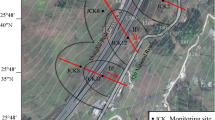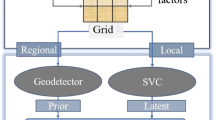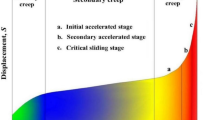Abstract
Predicting the deformation and evolution tendency of landslides is essential to landslide disaster prevention and mitigation. At present, most of the proposed models for landslide displacement prediction belong to single models. It is difficult to accurately describe the deformation and evolution law only by a single model for the complexity of landslides and limitation of the models. In this paper, we presented an application of linear combination model with optimal weight in landslide displacement prediction. We took Huanlongxicun and Saleshan landslides in Gansu province of China as examples, firstly to build GM(1,1) and Verhulst models for displacement prediction of the two landslides; then build two linear combination models of the two landslides, on the basis of the combining theory with optimal weight and the prediction results of the GM(1,1) and Verhulst models. The results show that the prediction accuracies of the combining models are much higher than those of the single models for both Huanglongxicun landslide and Saleshan landslide. Therefore, the combining model with optimal weight is an effective and feasible method to further improve accuracy for landslide displacement prediction.



Similar content being viewed by others
References
Abrahamsen P (2005) Combining methods for subsurface prediction. Quant Geol Geostat 14(3):601–610. doi:10.1007/978-1-4020-3610-1_61
Bates JM, Granger CWJ (1969) The combination of forecasts. Oper Res Q 20(4):150–157. doi:10.1057/jors.1969.103
Bunn DW (1989) Forecasting with more than one model. J Forecast 8(3):161–166. doi:10.1002/for.3980080302
Busslinger M (2009) Landslide time-forecast methods, a literature review towards reliable prediction of time to failure. HSR University of Applied Science, Rapperswil
Clemen RT (1989) Combining forecasts: a review and annotated bibliography. Int J Forecast 5(4):559–583. doi:10.1016/0169-2070(89)90012-5
Corominas J, Moya J, Ledesma A, Lloret A, Gili JA (2005) Prediction of ground displacements and velocities from groundwater level changes at the Vallcebre landslide. Landslides 2(2):83–96. doi:10.1007/s10346-005-0049-1
Crosta GB, Agliardi F (2002) How to obtain alert velocity thresholds for large rockslides? Phys Chem Earth 27(36):1557–1565. doi:10.1016/S1474-7065(02)00177-8
Deng JL (1987) Fundamentals of grey systems approaches. Huazhong University of Science and Technology Press, Wuhan
Dong H, Fu HL, Leng WM (2007) Nonlinear combination predicting based on support vector machines for landslide deformation. J China Railw Soc 29(1):132–136 (in Chinese)
Feng XT, Zhao HB, Li SJ (2004) Modeling non-linear displacement time series of geo-materials using evolutionary support vector machines. Int J Rock Mech Min Sci 41(7):1087–1107. doi:10.1016/j.ijrmms.2004.04.003
Fukuzono T (1985) A new method for predicting the failure time of a slope. In: Proceedings of the fourth international conference on landslides. Japan Landslide Society, Tokyo, pp 145–150. doi:10.1016/0148-9062(87)91524-5
Guermeur Y, Gallinari P (1996) Combining statistical models for protein secondary structure prediction. In: Proceedings of ICANN’96. Bochum, Germany, pp 599–604. doi:10.1007/3-540-61510-5_102
Hashem S (1993) Optimal linear combinations of neural network. Dissertation, Purdue University
Hashem S and Schmeiser B (1993) Approximating a function and its derivatives using MSE-optimal linear combinations of trained feedforward neural networks. In: Proceedings of the 1993 world congress on neural networks. Lawrence Erlbaum Associates, New Jersey, pp 617–620
Helmstetter A, Sornette D, Grasso JR, Andersen JV, Gluzman S and Pisarenko V (2004) Slider-block friction model for landslides: application to Vaiont and La Clapiere landslides. J Geophys Res 109:B02409, 1–15. doi:10.1029/2002JB002160
Huang RQ, Xu Q (1997) Synergetic prediction model of slope instability. Mt Res 15(1):7–12 (in Chinese)
Kayacan E, Ulutas B, Kaynak O (2010) Grey system theory-based models in time series prediction. Expert Syst Appl 37:1784–1789. doi:10.1016/j.eswa.2009.07.064
Li XZ, Xu Q (2003) Models and Criteria of Landslide Prediction. J Catastrophol 18(4):71–78 (in Chinese)
Li TB, Chen MD, Wang LS (1999) Landslide real-time tracking prediction. Chengdu University of Science and Technology Press, Chengdu
Li XP, Liu XX, Zhang AB, Sun Z (2009) Study in landslide prediction on genetic algorithm optimized BP network. J Hebei Univ Eng 26(1):69–71 (in Chinese)
Long H, Qin SQ, Zhu SP, Wan ZQ (2001) Nonlinear dynamic model and catastrophe analysis of slope evolution. J Eng Geol 9(3):331–335 (in Chinese)
Lu P, Rosenbaum MS (2003) Artificial neural networks and grey systems for the prediction of slope stability. Nat Hazards 30:383–398. doi:10.1023/B:NHAZ.0000007168.00673.27
Mufundirwa A, Fujii Y, Kodama J (2010) A new practical method for prediction of geomechanical failure-time. Int J Rock Mech Min Sci 47(7):1079–1090. doi:10.1016/j.ijrmms.2010.07.001
Neaupane KM, Achet SH (2004) Use of backpropagation neural network for landslide monitoring: a case study in the higher Himalaya. Eng Geol 74(3–4):213–226. doi:10.1016/j.enggeo.2004.03.010
Randall WJ (2007) Regression models for estimating coseismic landslide displacement. Eng Geol 91(2–4):209–218. doi:10.1016/j.enggeo.2007.01.013
Saito M (1965). Forecasting the time of occurrence of a slope failure. In: Proceedings of the 6th international conference on soil mechanics and foundation engineering, Montréal, Que. Pergamon Press, Oxford, pp 537–541
Sornette D, Helmstetter A, Andersen JV, Gluzman S, Grasso JR, Pisarenko V (2004) Towards landslide predictions: two case studies. Physica A: Stat Mech Appl 338(3–4):605–632. doi:10.1016/j.physa.2004.02.065
Voight B (1989) A relation to describe rate-dependent material failure. Science 243(4888):200–203. doi:10.1126/science.243.4888.200
Wang ZY, Xu Q, Fan XM, Zeng JH (2009) Application of renewal grey GM(1, 1) model to prediction of landslide deformation with two case studies. Hydrogeol Eng Geol 2:108–111 (in Chinese)
Wu YP, Teng WF, Li YW (2007) Application of grey-neural network model to landslide deformation prediction. Chin J Rock Mech Eng 26(3):632–636 (in Chinese)
Xu JL, Liao XP (1996) Prediction for Huangci landslide and its theory and method. Chin J Geol Hazard Control 7(3):18–25 (in Chinese)
Zhang ZY, Chen SM, Tao LJ (2002) 1983 sale mountain landslide, Gansu province, China. In: Evans SG, De Graff JV (ed), Catastrophic landslides: effects, occurrence, and mechanisms. The Geological Society of America, INC, Boulder, USA, pp 149–163
Acknowledgments
This research is supported by the National Natural Science Foundation of China (40802072), West Light Foundation of Chinese Academy of Sciences (O8R2140140) and Special Fund of Technology and Education in Yunnan province (2010A08-b). Special thanks to two anonymous reviewers and Professor Thomas Glade for their constructive comments and help.
Author information
Authors and Affiliations
Corresponding author
Rights and permissions
About this article
Cite this article
Li, X., Kong, J. & Wang, Z. Landslide displacement prediction based on combining method with optimal weight. Nat Hazards 61, 635–646 (2012). https://doi.org/10.1007/s11069-011-0051-y
Received:
Accepted:
Published:
Issue Date:
DOI: https://doi.org/10.1007/s11069-011-0051-y




